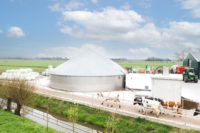Animal husbandry produces the potent greenhouse gas, methane and ammonia. However, emission estimates vary widely with few real world studies. A recent NASA-supported study released by Bubbleology Research International (BRI), Goleta, Calif., combined remote sensing with advanced mobile analyzers to understand how differing husbandry practices vary within dairies, between dairies and between regions.
"We designed a holistic experiment to characterize emissions, including source identification by using multiple gases for fingerprinting," says Dr. Ira Leifer, chief scientist and CEO. "We acquired and analyzed data from satellite, airborne remote sensing, mobile surface in situ and mobile surface remote sensing."
The experiment leveraged remote sensing of ammonia by the hyperspectral remote sensing imager, Mako, to make maps of ammonia.
The study looked at the Chino Dairies of San Bernardino County, Calif., which consists of about 45,000 cows on nearly 63 small dairies, surrounded by the Los Angeles Basin.
"It was very puzzling. The winter-summer difference is much larger than expected, however, it makes sense if it reflects legacy emissions, which are not currently considered," says Leifer.
Legacy emissions means that today's dairy emissions are not just from the number of cows today and their waste, but also what happened in prior years and even decades.
"Our research intends to find the best practices for dairymen to improve the environment while producing high-quality products," says professor Tryg Lundquist, a husbandry scientist at the California Polytechnic State University, San Luis Obispo, Calif.
Additional satellite data are being collected for the study by the Japanese Space Agency (JAXA) satellite, GOSAT.
"GOSAT has been targeting Chino husbandry for more than three years. Combining the surface, airborne and satellite column methane provides accurate and seamless flux information from the surface to the top of atmosphere," says Dr. Akihiko Kuze, a JAXA scientist.







